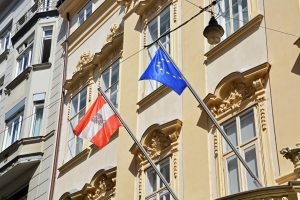“The restless heart is the root of pilgrimage. There is a longing in people that drives them out of the monotony of everyday life and out of the confines of their familiar surroundings,” is how the Augustinian canons of Herzogenburg Monastery describe pilgrimage, based on their order founder Augustine.
The monastery in Lower Austria is on the Way of St. James, one of the most famous pilgrimage routes. It has been used since the 11th century. At the latest since the bestseller "I'll be gone" by Hape Kerkeling, pilgrimage has experienced a real boom and has arrived in all parts of society. “Many pilgrims want to take a break or are looking for a new orientation. The motives are completely different, some people have had a difficult time, some would like to do something good for themselves,” explains Father Thomas Margreiter from Heiligenkreuz Abbey in the Vienna Woods, which is on the Via Sacra from Vienna to Mariazell. “Some make a pilgrimage out of faith, others because of sporting ambitions. I always recommend pilgrims to get involved and enjoy the time. You perceive nature differently and there is always the chance to make clear decisions, to discover a good direction. The path, like life, has ups and downs.”
Prior Father Gerwig Romirer also has a lot of experience with pilgrims. The Benedictines of the St. Lambrecht Abbey, from which Mariazell, the most important place of pilgrimage in Austria, was founded, have been taking care of the basilica and the people who make the pilgrimage there for centuries. “Whatever the underlying motive, a pilgrimage is always an experience, even if you don't consider yourself to be religious,” says Prior Father Gerwig Romirer. “Just leaving home, the stops along the way, taking a break, walking in all weathers and then arriving – these are experiences that trigger something in everyone. When you go on a pilgrimage, you are not only in motion on the outside, a lot also changes on the inside - some things dissolve, some things are awake and consciously perceived. Talking and reflecting on what happens along the way is an essential part of what we offer pilgrims at St. Lambrecht Abbey.”
His tip for the time after the pilgrimage: “It is important to give yourself some space and time so that everyday life doesn’t immediately pull you back into the whirlpool. The things that they became aware of along the way should accompany the pilgrims for a while. This can be a thought for one person and a ritual that one has grown fond of along the way for another. I encourage pilgrims to take a symbol of this - a picture or something from nature such as a stone. This serves as a kind of anchor at home and can have great symbolic power.”
In addition to Herzogenburg, Heiligenkreuz and St. Lambrecht, many more of the almost 30 monasteries and orders of Klösterreich are located on pilgrimage routes and offer special offers for pilgrims and anyone who would like to try pilgrimage, a few examples:
With llamas on the Way of St. James: In two days, the old pilgrimage route, which was revived in 2004, leads from Göttweig Abbey to Melk Abbey. Beginners discover the fascination of pilgrimage on the 44-kilometer spiritual journey through the Dunkelsteiner Forest, among other places. If you want, you can use llamas as beasts of burden or the new offer “pilgrim hikes without luggage”.
The monastery of Heiligenkreuz and Lilienfeld are located on the Via Sacra, Austria's oldest pilgrimage route. They offer pilgrims time out and days of silence. Guests have access to the church, the cloister, the cloister garden and the chapter house at all times and are invited to the prayer times of the Cistercians. A beautiful pilgrim souvenir from Lilienfeld are the lilies from the monastery shop.
You can appreciate the beauty of nature and marvel at creation during meditation and hiking with Abbot Lukas in Schlägl Abbey (July 30.07th to August 4.08.2023th, XNUMX). Walking in silence and being in silence are essential elements of the course, about four to five hours of hiking every day.
You can calm down through movement during meditative hiking weeks (e.g. August 7th to 12.08.2023th, XNUMX) and pilgrimage weekends of the Benedictines from St. Lambrecht Abbey in the Styrian mountains. The "time-out diary" and a nature log provide inspiration for the time afterwards.
In the Marian Sisters' health resort in Bad Kreuzen, you can combine hikes in the Strudengau with Kneipp treatments. The Curhaus, which is also the first center for Traditional European Medicine (TEM), is located directly on the long-distance Donausteig hiking trail and is ideal for a pilgrim rest lasting several days and a feel-good break. Mindfulness, arriving at yourself, deceleration, self-regeneration and self-healing are values of pilgrimage and TEM in the Kurhaus. Those who prefer to travel by bike can book the "Cycling for the soul" package (all year round for 3, 4 or 6 nights) in Bad Kreuzen and explore the Mühlviertel by bike or e-bike.
On August 25, the Upper Austrian part of the Benedict pilgrimage route is officially opened in Kremsmünster Abbey. Under the motto "From monastery to monastery", 370 km of footpaths and cycle paths were created. You can use it to go from Passau to Spital am Pyhrn or do the Traunviertel pilgrimage route. The Benedict pilgrimage project has been running since 2009. It was created on the occasion of the 200th anniversary of the repopulation of the St. Paul Abbey in the Lavanttal in Carinthia. When completed, the route will extend south to the monastery of Montecassino, from where the Benedictine order emanated, and north to Pluscarden in Scotland, the most northerly Benedictine abbey, totaling 4.000 km.




